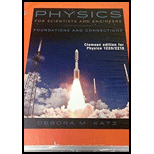
Concept explainers
(a)
The average velocity of the particles.
(a)
Answer to Problem 6PQ
The average velocity of the particles is
Explanation of Solution
Write the equation for the average velocity in the x direction for the particles.
Here,
Write the equation for the average velocity in the y direction for the particles.
Here,
Write the equation for the average velocity in the z direction for the particles.
Here,
Write the equation for the average velocity of the particles.
Conclusion:
Substitute
Substitute
Substitute
Substitute
Thus, the average velocity of the particles is
(b)
The average speed of the particles.
(b)
Answer to Problem 6PQ
The average speed of the particles is
Explanation of Solution
Write the equation for the speedof the first particle.
Write the equation for the average speed.
Conclusion:
Substitute
Similarly, calculate the speed of the second particle.
Calculate the speed of the third particle.
Calculate the speed of the fourth particle.
Calculate the speed of the fifth particle.
Substitute
Thus, the average speed of the particles is
(c)
The rms speed of the particles.
(c)
Answer to Problem 6PQ
The rms speed of the particles is
Explanation of Solution
Write the equation for the rms speed of the particles.
Conclusion:
Substitute the values for the speeds of the particles in equation (VII) to find
Thus, the rms speed of the particles is
(d)
Compare the speeds of the particles.
(d)
Answer to Problem 6PQ
The rms speed is greater than the average speed.
Explanation of Solution
Write the equation for the magntide of the average velocity.
Here,
Conclusion:
Susbtitute
The value of rms speed is greater than the mahnitude of the average velocity. This is becauses, in calculationg the average velocity, the particles moving in the opposite direction is also considered.
Thus, the rms speed is greater than the average speed.
Want to see more full solutions like this?
Chapter 20 Solutions
Physics for Scientists and Engineers: Foundations and Connections
- (a) For a spherical capacitor with inner radius a and outer radius b, we have the following for the capacitance. ab C = k₂(b- a) 0.0695 m 0.145 m (8.99 × 10º N · m²/c²)( [0.145 m- 0.0695 m × 10-11 F = PF IIarrow_forwardA pendulum bob A (0.5 kg) is given an initialspeed of vA = 4 m/s when the chord ishorizontal. It then hits a stationary block B (1kg) which then slides to a maximum distanced before it stops. Determine the value of d.The coefficient of static friction between theblock and the plane is μk = 0.2. The coefficientof restitution between A and B is e = 0.8.Ans: d=1.0034 marrow_forwardFigure 29-43 Problem 12. ••13 In Fig. 29-44, point P₁ is at distance R = 13.1 cm on the perpendicular bisector of a straight wire of length L = 18.0 cm carrying current i = 58.2 mA. (Note that the wire is not long.) What is the magnitude of the magnetic field at P₁ due to i? P2° R R Larrow_forward
- Checkpoint 1 The figure shows the current i in a single-loop circuit with a battery B and a resistance R (and wires of neg- ligible resistance). (a) Should the emf arrow at B be drawn pointing leftward or rightward? At points a, B C R b, and c, rank (b) the magnitude of the current, (c) the electric potential, and (d) the electric potential energy of the charge carriers, greatest first.arrow_forwardPls help ASAParrow_forwardPls help asaparrow_forward
 Principles of Physics: A Calculus-Based TextPhysicsISBN:9781133104261Author:Raymond A. Serway, John W. JewettPublisher:Cengage Learning
Principles of Physics: A Calculus-Based TextPhysicsISBN:9781133104261Author:Raymond A. Serway, John W. JewettPublisher:Cengage Learning Physics for Scientists and Engineers: Foundations...PhysicsISBN:9781133939146Author:Katz, Debora M.Publisher:Cengage Learning
Physics for Scientists and Engineers: Foundations...PhysicsISBN:9781133939146Author:Katz, Debora M.Publisher:Cengage Learning Physics for Scientists and Engineers, Technology ...PhysicsISBN:9781305116399Author:Raymond A. Serway, John W. JewettPublisher:Cengage Learning
Physics for Scientists and Engineers, Technology ...PhysicsISBN:9781305116399Author:Raymond A. Serway, John W. JewettPublisher:Cengage Learning Classical Dynamics of Particles and SystemsPhysicsISBN:9780534408961Author:Stephen T. Thornton, Jerry B. MarionPublisher:Cengage Learning
Classical Dynamics of Particles and SystemsPhysicsISBN:9780534408961Author:Stephen T. Thornton, Jerry B. MarionPublisher:Cengage Learning Modern PhysicsPhysicsISBN:9781111794378Author:Raymond A. Serway, Clement J. Moses, Curt A. MoyerPublisher:Cengage Learning
Modern PhysicsPhysicsISBN:9781111794378Author:Raymond A. Serway, Clement J. Moses, Curt A. MoyerPublisher:Cengage Learning Physics for Scientists and EngineersPhysicsISBN:9781337553278Author:Raymond A. Serway, John W. JewettPublisher:Cengage Learning
Physics for Scientists and EngineersPhysicsISBN:9781337553278Author:Raymond A. Serway, John W. JewettPublisher:Cengage Learning





